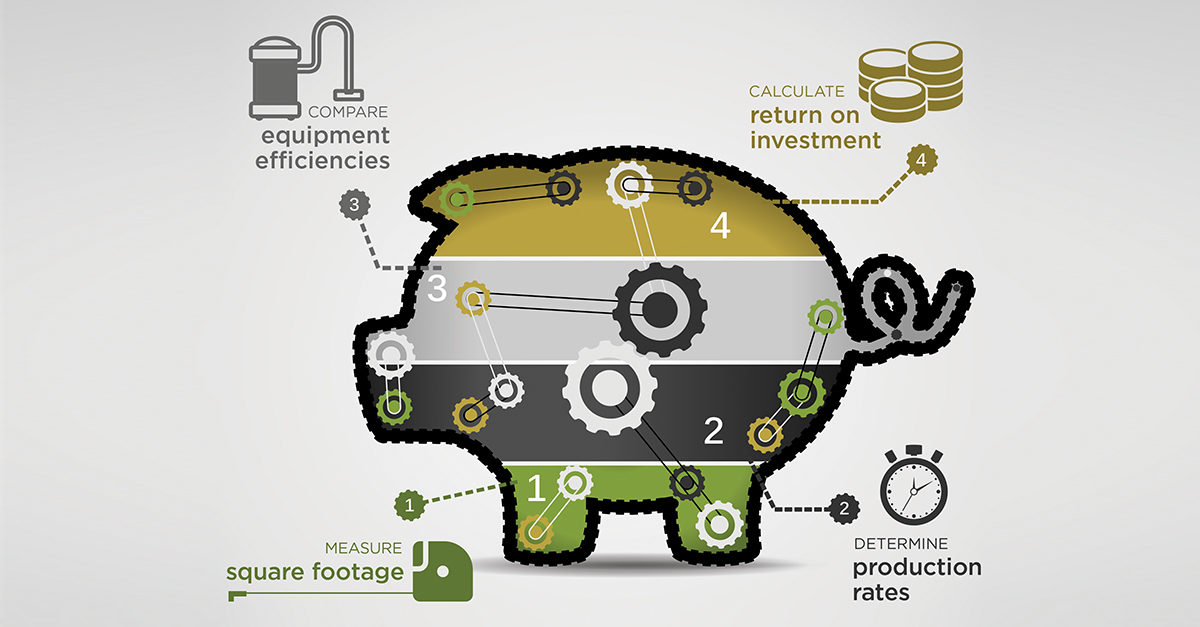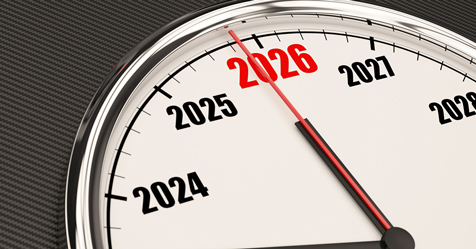Today more than ever, it’s important to understand how long it takes to clean your building. With budgets and resources declining, you cannot afford to have waste in your processes.
When purchasing equipment, be sure to understand its financial impact on your business. You should have a good understanding of how long it will take to clean the areas while using that particular equipment. It may shock you to see the impact of even small changes in equipment size and productivity on your business.
Calculating Size and Space
First examine the size of the area requiring cleaning. Measure out the area and determine the total square footage that you plan to clean. This can be done with a laser tape measure, using measurements from a blueprint, or in the case of the VCT floor, you can even count the tiles to multiply the length and width. Regardless of how you do it, it’s important to start with an understanding of how much square footage you plan to clean.
The next thing you have to consider is the density of the space. Is it a wide open space like a ballroom or corridor? Are you cleaning offices that have desks, chairs, and tables? Understanding the density of the space is important because there is a significant difference between how you maintain 20,000 square feet of empty ballroom space versus 20,000 square feet of cubicles. While you may clean all 20,000 square feet of the ballroom, you may only have 8,000 square feet of cleanable space in the cubicles. Furthermore, understanding how much space there is for maneuvering equipment will help you select the right equipment for that area.
Calculating Production Rates
Once you determine the size of the area to clean, figure out how long it will take to clean it with the equipment you are considering. To do this, you will need to know how many square feet per hour the equipment can clean. There are a number of ways to determine this:
- You can use manufacturer’s practical (not theoretical) production rates.
- You can use ISSA’s 612 Cleaning Times to provide a third-party production rate.
- You can calculate the production rate of the cleaning process yourself.
To calculate the production rate of the cleaning process yourself, simply measure out an area that is representative of the area you plan to clean or clean the entire area, depending on which makes sense for your purposes. A worker should clean the area at a realistic pace and time. If you use a smaller area as a guide—say 1,000 square feet—you can use the time it takes to complete the task to calculate how long it will take to clean a larger area (for example, 10,000 square feet).
Equipment Expectations
Very often cleaning professionals do not understand what they should expect from a piece of equipment. For instance, if you give a worker a 12-inch single-motor upright vacuum, how much should you expect the worker to vacuum per hour with that tool?
ISSA’s 612 Cleaning Times helps to establish a good baseline for cleaning production rates. For people managing cleaning operations, this is a go-to tool when calculating how to clean and how long it should take.
Looking at the previously-mentioned example, the 612 Cleaning Times would tell us that a 12-inch single-motor upright vacuum should vacuum 2,239 square feet per hour. If I am expecting 5,000 square feet per hour, I am not getting a good result.
So, what would be the impact of switching from a 12-inch single-motor upright vacuum to an 18-inch dual-motor upright vacuum in the same application? Here we are assuming that the 18-inch dual-motor is the right vacuum for the area and the worker, but assuming it is, how would that impact our business?
First, the 18-inch dual-motor vacuum would cost a few hundred dollars more than the 12-inch single-motor vacuum to purchase, so let’s just assume there is a price difference of US$500 between the vacuums. Many purchasing decisions are made on that figure alone, but let’s explore this further.
ISSA’s 612 Cleaning Times shows us that the production rate for an 18-inch dual-motor vacuum is 4,000 square feet per hour. In order to keep the math simple, let’s assume the area we are looking to vacuum:
- Has an area of 4,000 square feet daily
- Will occur Monday through Friday
- Will pay a single worker $15 per hour, which includes benefits.
In this scenario, it takes:
- 108 minutes to vacuum 4,000 square feet with a 12-inch single-motor upright vacuum
- 60 minutes to vacuum 4,000 square feet with an 18-inch dual-motor upright vacuum.
Now, consider this math:
- The 18-inch dual-motor vacuum saves 48 minutes per vacuuming.
- The area is vacuumed 5 days per week, for a total savings of 240 minutes (5 days x 48 minutes = 240 minutes).
- 240 minutes is equal to 4 hours saved per week (240 minutes ÷ 60 minutes = 4 hours)
- 4 hours saved per week x 52 weeks of cleaning per year = 208 hours saved per year.
What we learn is that the impact of simply switching from a 12-inch single-motor upright vacuum to an 18-inch dual-motor upright vacuum is pretty significant for our business. Just in making that switch, we freed up 4 hours of labor each week that can be used to address areas that we currently do not have time to clean and maintain.
Putting the Savings into Perspective
Another way to think about those 4 hours is that they represent one-tenth of a full-time employee.
Many people who manage cleaning in facilities have found they are losing labor hours through budget cuts or just not being able to replace workers who leave or retire. Here the 4 hours we have saved by switching vacuums allows a manager to recover 10 percent of a full-time employee’s time that may have been lost.
Let’s take this one step further. We established the labor rate as $15 per hour, including benefits. If we multiply the 208 hours we are going to save on vacuuming by the $15 per hour labor rate, we find an annual savings of $3,120—just by switching vacuums. This far outweighs the $500 price difference we established between the vacuums.
Calculating Long-Term Savings
An annual savings of $3,120 throughout the course of 12 months comes out to a savings of $260 per month. At this point, we need to determine two things: the payback period and the return on investment of the equipment.
Payback Period: This is the length of time it will take for the labor savings we see with the equipment to surpass the amount of the investment we have made in it. In this case, let’s assume that an 18-inch dual-motor vacuum typically costs somewhere around $1,000 to purchase. If we are saving $260 in labor every month after purchasing this new piece of equipment, it will take 4 months to recoup our investment (We would save $1,040 in labor during that time).
Return on Investment: Once we have recouped our initial investment, any additional labor savings will contribute to your return on investment—or ROI. Since we are still saving $260 per month in labor dollars after we have recouped our investment for the vacuum, any additional savings after the first $1,000 will contribute to the ROI.
Now let’s assume our vacuum will last 5 years (or 60 months). If we continuously save $260 per month in labor dollars and the first 4 months of service count toward the payback period, the next 56 months will show an ROI of $14,560 in labor dollars.
An hourly and financial impact like that clearly demonstrates the importance of comparing new equipment to current equipment as well as different equipment you may want to consider using in your facilities. Not making informed decisions can severely impact your ability to meet your cleaning goals.
Maximizing Your Potential
A good friend of mine who is an expert in lean manufacturing processes once told me that our capacity to accomplish tasks is most often stored in the form of waste in our current processes. Throughout the years, I have found this to be true.
If you take the time to analyze and make sure you understand what to expect out of your cleaning processes, I have no doubt that you will find and eliminate waste in your schedule and budget. Right-sizing your equipment is the first step.




